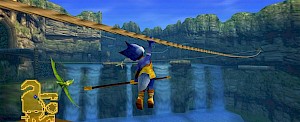Review: Teslagrad

Posted 16 Dec 2017 at 18:54 by Anil Parmar
As the main menu fades, a father drops his son off at home. Anxiously, he walks away, and the rest of his fate remains unknown. A year passes, and as your home is stormed by troops in red coats, your mother urges you to flee the small town that you know as your home. As you run past and evade each troop that tries to capture you, you come across a drawbridge that leads you in to the stratospheric tower in which Teslagrad is set. The beauty of Teslagrad is that, much like its story, it is a game that revels in minimalism.
Teslagrad, produced by Norwegian indie developer Rain Games, is the latest in a number of acclaimed indie titles making their way to the Nintendo Switch, and the puzzle platformer is one that shouldn’t be overlooked. The first thing you’ll notice about Teslagrad is the beauty of the art design. From the opening moments of the game to the boss battles that await the player, Teslagrad is as good to look as it was during its initial release on PC back in 2013. Whether you play the game in docked or undocked mode, the vibrant and expressive hand-drawn is wonderful to look at. From the bolts of electricity to the tower interiors, the art style is somewhat reminiscent of Windsor McCay’s Little Nemo, and that’s certainly not bad thing.

Many games have used environmental storytelling to good effect over the years but I don’t think I’ve seen a game deliver a fascinating story without speech bubbles or text in the way that Teslagrad does. From the opening cutscene to the imagery spotted throughout the game, Teslagrad does a superb job of making the player wonder what events took place in this world. Occasionally the player will stumble across an in-game theatre, which uses puppets to show off events that led to a previous war. These scenes are however completely optional and are the closest the game comes to pushing any sense of narrative towards the player.
This means that most of the players time in Teslagrad is spent understanding and solving the puzzles that are scattered throughout the castle. All the puzzles revolve around electricity and laws of attraction – objects and magnetic fields will regularly emit either a blue or red light, and interacting with these objects causes an attractive or repulsive force. It’s a simple mechanic but the one the game takes quite far, and some puzzles even require impressive use of the momentum caused by a repulsive force to let the player reach higher areas.
Solving puzzles and moving from one room to the next generally involves ascending the central tower in Teslagrad, but the game also makes use of a Metroidvania upgrade system to reward exploration and to also hide harder areas behind a barrier. At the beginning of the game the player will be able to do no more than jump and to change objects from red magnetism to blue magnetism (attractive and repulsive) but you’ll soon unlock extra abilities, including the ability to cloak yourself in one of the magnetic charges. Understanding these abilities is essential to progressing through the game but mastering them and having a thorough understanding of how objects interact with each other allows you to find a number of hidden scrolls littered throughout the world, all of which are needed for the true ending.

Whilst the gameplay is generally very strong, there are two things that I found frustrating throughout my five hour play through. The first is the lack of a decent map system – for any game that encourages seeking out collectibles and the occasional backtracking, a good map system is needed to help remind the player of key areas. A map is present in Teslagrad but it lacks detail, and it’s easy to forget where you saw a hidden item or alternative path.
The second issue I found was the controls; whether I was using the pseudo d-pad on the joy-con or an analogue stick, the digital movement of the main character often left me misplacing jumps. Giving that platforming is such a big part of Teslagrad; it’s a shame that the controls don’t feel as tight as I would have hoped. It’s not a deal breaker, it’s just a slight frustration.
And I guess nit-picking on those two points sums up how great of an experience Teslagrad is. The wonderfully subdued music and sound effects, combined with the beautiful art design, create an immersive world. The story telling is done so subtlety yet by the end I had experienced moments of joy and heartbreak. The presentation in Teslagrad created a world of wonder, and the varied environments kept me coming for me. The magnetism concept was also very well delivered, and the team deserve credit for creating a realistic model for how magnetic objects work. Generally speaking the puzzles are fairly easy to solve if you take some time to understand the challenge in front of you and from my experience, none of the puzzles were unfairly challenging.
If you didn’t play Teslagrad during its initial 2013 run, definitely consider purchasing this wonderful puzzle platformer. It is a beautiful game with a thought provoking story and a very clever gameplay mechanic. It therefore feels right at home on Nintendo’s latest system.
N-Europe Final Verdict
A beautiful and enjoyable puzzle platformer game. If you have not played Teslagrad previously, or if its been a while, the Switch version is definitely worth picking up.
- Gameplay4
- Playability4
- Visuals5
- Audio4
- Lifespan4
Final Score
8
Pros
Art style and visuals
Excellent story
Impressive range of puzzles
Cons
Lack of decent map makes backtracking difficult
Loose controls
























